Predicting Fatigue in Long Duration Mountain Events with a Single Sensor and Deep Learning Model
Abstract
1. Introduction
1.1. Why We Need to Measure Physical and Cognitive Fatigue in the Field
1.2. How We Can Measure Physical and Cognitive Fatigue in the Lab and the Field
- -
- Determine whether cognitive and physical fatigue could be accurately predicted by an AI model using data from a single sensor capable of being worn in an endurance activity for multiple days, measuring acceleration and ECG in an outdoor environment with voluntary activity.
- -
- Additionally propose a protocol for data collection in an unsupervised remote environment with no manual labelling by the participant
- -
- Determine if environmental parameters would affect accuracy, including; random activity, self-pacing, terrain surface (concrete, gravel, dirt, mud grass), and slope (flat, up and down slopes)
2. Materials and Methods
2.1. Ethics
2.2. Protocol—Physical and Cognitive Load and Performance Assessments
2.3. Data Preparation
2.4. Convolutional Neural Network
2.5. Statistics
3. Results
4. Discussion
Limitations
5. Conclusions
Author Contributions
Funding
Institutional Review Board Statement
Informed Consent Statement
Conflicts of Interest
References
- Phillips, R.O. A review of definitions of fatigue—And a step towards a whole definition. Transp. Res. Part F Traffic Psychol. Behav. 2015, 29, 48–56. [Google Scholar] [CrossRef]
- Caldwell, J.A.; Caldwell, J.L.; Brown, D.L.; Smith, J.K. The Effects of 37 Hours of Continuous Wakefulness On the Physiological Arousal, Cognitive Performance, Self-Reported Mood, and Simulator Flight Performance of F-117A Pilots. Mil. Psychol. 2004, 16, 163–181. [Google Scholar] [CrossRef]
- Thomas, L.C.; Gast, C.; Grube, R.; Craig, K. Fatigue Detection in Commercial Flight Operations: Results Using Physiological Measures. Procedia Manuf. 2015, 3, 2357–2364. [Google Scholar] [CrossRef][Green Version]
- Vural, E.; Çetin, M.; Erçil, A. Machine Learning Systems for Detecting Driver Drowsiness. In Digital Signal Processing for In-Vehicle Systems and Safety; Springer: Boston, MA, USA, 2007; pp. 16937–16953. [Google Scholar]
- Desai, A.V.; Haque, M.A. Vigilance monitoring for operator safety: A simulation study on highway driving. J. Saf. Res. 2006, 37, 139–147. [Google Scholar] [CrossRef] [PubMed]
- Correa, A.G.; Orosco, L.; Laciar, E. Automatic detection of drowsiness in EEG records based on multimodal analysis. Med. Eng. Phys. 2014, 36, 244–249. [Google Scholar] [CrossRef] [PubMed]
- Von Jan, T.; Karnahl, T.; Seifert, K.; Hilgenstock, J.; Zobel, R. Don’t sleep and drive—VW’s fatigue detection technology. In Proceedings of the 19th International Conference on Enhanced Safety of Vehicles, Washington, DC, USA, 6 June 2005; pp. 1–12. [Google Scholar]
- Chen, L.L.; Zhao, Y.; Zhang, J.; Zou, J.Z. Automatic detection of alertness/drowsiness from physiological signals using wavelet-based nonlinear features and machine learning. Expert Syst. Appl. 2015, 42, 7344–7355. [Google Scholar] [CrossRef]
- Duncan, M.J.; Fowler, N.; George, O.; Joyce, S.; Hankey, J. Mental Fatigue Negatively Influences Manual Dexterity and Anticipation Timing but not Repeated High-intensity Exercise Performance in Trained Adults. Res. Sports Med. 2015, 23, 1–13. [Google Scholar] [CrossRef] [PubMed]
- Park, K.; Rosengren, K.S.; Horn, G.P.; Smith, D.L.; Hsiao-Wecksler, E.T. Assessing gait changes in firefighters due to fatigue and protective clothing. Saf. Sci. 2011, 49, 719–726. [Google Scholar] [CrossRef]
- Smith, B.P.; Browne, M.; Armstrong, T.A.; Ferguson, S.A. The accuracy of subjective measures for assessing fatigue related decrements in multi-stressor environments. Saf. Sci. 2016, 86, 238–244. [Google Scholar] [CrossRef]
- Dawson, D.; Reid, K. Fatigue alcohol and performance impairment. Nature 1997, 388, 235–237. [Google Scholar] [CrossRef] [PubMed]
- Davis, M.P.; Walsh, D. Mechanisms of Fatigue. J. Support Oncol. 2010, 8, 164–174. [Google Scholar] [CrossRef]
- Noakes, T.D. Fatigue is a brain-derived emotion that regulates the exercise behavior to ensure the protection of whole body homeostasis. Front. Physiol. 2012, 82. [Google Scholar] [CrossRef]
- Hampson, D.B.; Gibson, A.S.; Lambert, M.I.; Noakes, T.D. The Influence of Sensory Cues on the Perception of Exertion During Exercise and Central Regulation of Exercise Performance. Sports Med. 2001, 31, 935–952. [Google Scholar] [CrossRef]
- Siirtola, P.; Laurinen, P.; Haapalainen, E.; Röning, J.; Kinnunen, H. Clustering-based activity classification with a wrist-worn accelerometer using basic features. In Proceedings of the 2009 IEEE Symp. Comput. Intell. Data Mining, CIDM 2009-Proc., Nashville, TN, USA, 2 April 2009; Volume 44, pp. 95–100. [Google Scholar] [CrossRef]
- Noakes, T.D. Physiological models to understand exercise fatigue and the adaptations that predict or enhance athletic performance. Med. Sci. Sports 2000, 123–145. [Google Scholar] [CrossRef] [PubMed]
- Van Cutsem, J.; Marcora, S.; De Pauw, K.; Bailey, S.; Meeusen, R.; Roelands, B. The Effects of Mental Fatigue on Physical Performance: A Systematic Review. Sports Med. 2017, 47, 1569–1588. [Google Scholar] [CrossRef]
- Hill, A.V.; Long, C.N.H.; Lupton, H. Muscular Exercise Lactic Acid and the Supply and Utilisation of Oxygen. Proc. R. Soc. 1924, 97, 155–176. [Google Scholar] [CrossRef]
- Borg, G.; Borg, E. To determine the magnitude of pain with Borg. In Proceedings of the Fechner Day 2014—30th Annual Meeting International Society for Psychophysics, Lund, Sweden, 18 August 2014; Volume 45, p. 16. [Google Scholar]
- Millet, G.Y.; Tomazin, K.; Verges, S.; Vincent, C.; Bonnefoy, R.; Boisson, R.C.; Gergelé, L.; Féasson, L.; Martin, V. Neuromuscular consequences of an extreme mountain ultra-marathon. PLoS ONE 2011, 6, e17059. [Google Scholar] [CrossRef]
- Venhorst, A.; Micklewright, D.; Noakes, T.D. Perceived Fatigability: Utility of a Three-Dimensional Dynamical Systems Framework to Better Understand the Psychophysiological Regulation of Goal-Directed Exercise Behaviour. Sports Med. 2018, 2479–2495. [Google Scholar] [CrossRef] [PubMed]
- Boksem, M.A.; Tops, M. Mental fatigue: Costs and benefits. Brain Res. Rev. 2008, 59, 125–139. [Google Scholar] [CrossRef]
- Möckel, T.; Beste, C.; Wascher, E. The Effects of Time on Task in Response Selection—An ERP Study of Mental Fatigue. Nat. Publ. Gr. 2015, 5, 10113. [Google Scholar] [CrossRef] [PubMed]
- Aoyagi, M.W.; Portenga, S.T. The Role of Positive Ethics and Virtues in the Context of Sport and Performance Psychology Service Delivery. Prof. Psychol. Res. Pract. 2010, 41, 253–259. [Google Scholar] [CrossRef]
- Portenga, S.T.; Aoyagi, M.W.; Cohen, A.B. Helping to build a profession: A working definition of sport and performance psychology. J. Sport Psychol. Action 2017, 8, 47–59. [Google Scholar] [CrossRef]
- Lambert, E.V.; Gibson, A.S.C.; Noakes, T.D. Complex systems model of fatigue: Integrative homoeostatic control of peripheral physiological systems during exercise in humans. Br. J. Sports Med. 2004, 39, 52–62. [Google Scholar] [CrossRef] [PubMed]
- Pimenta, A.; Carneiro, D.; Neves, J.; Novais, P. A neural network to classify fatigue from human-computer interaction. Neurocomputing 2016, 172, 413–426. [Google Scholar] [CrossRef]
- Abdulin, E. User Fatigue Detection via Eye Movement Behavior. In Proceedings of 33rd Annual ACM Conference Extended Abstracts on Human Factors in Computing Systems, Seoul, Korea, 18 April 2015. [Google Scholar]
- Gonzalez, K.; Sasangohar, F.; Mehta, R.; Lawley, M.; Erraguntla, M. Measuring Fatigue through Heart Rate Variability and Activity Recognition: A Scoping Literature Review of Machine Learning Techniques. In Proceedings of the Human Factors and Ergonomics Society Annual Meeting, Rome, Italy, 28–30 September 2017; p. 1748. [Google Scholar]
- Patel, A.N.; Howard, M.D.; Roach, S.M.; Jones, A.P.; Bryant, N.B.; Robinson, C.S.H.; Clark, V.P.; Pilly, P.K. Mental State Assessment and Validation Using Personalized Physiological Biometrics. Front. Hum. Neurosci. 2018, 12, 221. [Google Scholar] [CrossRef]
- Azim, T.; Jaffar, M.A.; Mirza, A.M. Fully automated real time fatigue detection of drivers through Fuzzy Expert Systems. Appl. Soft Comput. J. 2014, 18, 25–38. [Google Scholar] [CrossRef]
- Enoka, R.; Duchateau, J. Translating fatigue to human performance. Meical Sci. Sports Exerc. 2016, 48, 2223–2238. [Google Scholar] [CrossRef]
- Zhu, Y.; Jankay, R.R.; Pieratt, L.C.; Mehta, R.K. Wearable sensors and their metrics for measuring comprehensive occupational fatigue: A scoping review. In Proceedings of the Human Factors and Ergonomics Society Annual Meeting, Austin, TX, USA, 9–13 October 2017; pp. 1041–1045. [Google Scholar] [CrossRef]
- Qi, W.; Su, H.; Aliverti, A. A Smartphone-Based Adaptive Recognition and Real-Time Monitoring System for Human Activities. IEEE Trans. Hum. Mach. Syst. 2020, 50, 414–423. [Google Scholar] [CrossRef]
- Qi, W.; Su, H.; Yang, C.; Ferrigno, G.; De Momi, E.; Aliverti, A. A fast and robust deep convolutional neural networks for complex human activity recognition using smartphone. Sensors 2019, 19, 3731. (In Switzerland) [Google Scholar] [CrossRef]
- Granacher, U.; Wolf, I.; Wehrle, A.; Bridenbaugh, S.; Kressig, R.W. Effects of muscle fatigue on gait characteristics under single and dual-task conditions in young and older adults. J. Neuroeng. Rehabil. 2010, 7, 56. (In Switzerland) [Google Scholar] [CrossRef] [PubMed]
- Fuller, J.T.; Bellenger, C.R.; Thewlis, D.; Arnold, J.; Thomson, R.L.; Tsiros, M.D.; Robertson, E.Y.; Buckley, J.D. Tracking performance changes with running-stride variability when athletes are functionally overreached. Int. J. Sports Physiol. Perform. 2017, 12, 357–363. [Google Scholar] [CrossRef] [PubMed]
- Heredia-Jimenez, J.; Latorre-Roman, P.; Santos-Campos, M.; Orantes-Gonzalez, E.; Soto-Hermoso, V.M. Spatio-temporal gait disorder and gait fatigue index in a six-minute walk test in women with fibromyalgia. Clin. Biomech. 2016, 33, 1–6. [Google Scholar] [CrossRef]
- Marcora, S.M.; Staiano, W.; Manning, V. Mental fatigue impairs physical performance in humans. J. Appl. Physiol. Publ. 2009, 106, 857–864. [Google Scholar] [CrossRef] [PubMed]
- Roelands, B.; De Koning, J.; Foster, C.; Hettinga, F.; Meeusen, R. Neurophysiological determinants of theoretical concepts and mechanisms involved in pacing. Sports Med. 2013, 43, 301–311. [Google Scholar] [CrossRef] [PubMed]
- Borghini, G.; Astolfi, L.; Vecchiato, G.; Mattia, D.; Babiloni, F. Measuring neurophysiological signals in aircraft pilots and car drivers for the assessment of mental workload, fatigue and drowsiness. Neurosci. Biobehav. Rev. 2014, 44, 58–75. [Google Scholar] [CrossRef]
- Russell, B.; McDaid, A.; Toscano, W.; Hume, P. Moving the Lab into the Mountains: A Pilot Study of Human Activity Recognition in Unstructured Environments. Sensors 2021, 21, 654. [Google Scholar] [CrossRef] [PubMed]
- Wang, G.; Li, Q.; Wang, L.; Wang, W.; Wu, M.; Liu, T. Impact of sliding window length in indoor human motion modes and pose pattern recognition based on smartphone sensors. Sensors 2018, 18, 1965. (In Switzerland) [Google Scholar] [CrossRef] [PubMed]
- Yoon, H.; Hwan, S.; Ho, S.; Choi, J.; Jin, Y. Wakefulness evaluation during sleep for healthy subjects and OSA patients using a patch-type device. Comput. Methods Progr. Biomed. 2018, 155, 127–138. [Google Scholar] [CrossRef]
- Gordienko, Y.; Stirenko, S.; Kochura, Y.; Alienin, O.; Novotarskiy, M.; Gordienko, N. Deep Learning for Fatigue Estimation on the Basis of Multimodal Human-Machine Interactions. arXiv 2017, arXiv:1801.06048. [Google Scholar]
- van der Westhuizen, J.; Lasenby, J. A Review of Machine Learning Applied to Time Series; Technical Report; Cambridge University Engineering Department: Cambridge, UK, 2016; CUED/F-INFENG/TR.702:0951-9211. [Google Scholar]
- Ignatov, A. Real-time human activity recognition from accelerometer data using Convolutional Neural Networks. Appl. Soft Comput. J. 2018, 62, 915–922. [Google Scholar] [CrossRef]
- Tripathi, S.; Acharya, S.; Sharma, R.D.; Mittal, S.; Bhattacharya, S. Using Deep and Convolutional Neural Networks for Accurate Emotion Classification on DEAP Dataset. In Proceedings of the Twenty-Ninth IAAI Conference, San Francisco, CA, USA, 6 February 2017; pp. 4746–4752. [Google Scholar]
- Laurent, F.; Valderrama, M.; Besserve, M.; Guillard, M.; Lachaux, J.P.; Martinerie, J.; Florence, G. Multimodal information improves the rapid detection of mental fatigue. Biomed. Signal Process. Control 2013, 8, 400–408. [Google Scholar] [CrossRef]
- Grobe, S.; Kakar, R.S.; Smith, M.L.; Mehta, R.; Baghurst, T.; Boolani, A. Impact of cognitive fatigue on gait and sway among older adults: A literature review. Prev. Med. Rep. 2017, 6, 88–93. [Google Scholar] [CrossRef]
- Vanhatalo, A.; Jones, A.M.; Burnley, M. Application of Critical Power in Sport What Is the Critical Power Concept. Int. J. Sports Physiol. Perform. 2011, 6, 128–136. [Google Scholar] [CrossRef] [PubMed]
- Miyake, S.; Yamada, S.; Shoji, T.; Takae, Y.; Kuge, N.; Yamamura, T. Physiological responses to workload change. A test/retest examination. Appl. Ergon. 2009, 40, 987–996. [Google Scholar] [CrossRef]
- Gibson, A.S.C.; Goedecke, J.H.; Harley, Y.X.; Myers, L.J.; Lambert, M.I.; Noakes, T.D.; Lambert, E.V. Metabolic setpoint control mechanisms in different physiological systems at rest and during exercise. J. Theor. Biol. 2005, 236, 60–72. [Google Scholar] [CrossRef] [PubMed]
- Wickens, C.D.; Keller, J.W.; Shaw, C. Human Factors in High-Altitude Mountaineering. J. Hum. Perform. Extrem. Environ. 2015, 12, 5–8. [Google Scholar] [CrossRef]
- Apple Research Kit. Available online: https://developer.apple.com/researchkit/ (accessed on 12 June 2018).
- Cherry, B.J.; Zettel-Watson, L.; Chang, J.C.; Shimizu, R.; Rutledge, D.N.; Jones, C.J. Positive associations between physical and cognitive performance measures in fibromyalgia. Arch. Phys. Med. Rehabil. 2012, 93, 62–71. [Google Scholar] [CrossRef] [PubMed]
- Lee, C.Y.; Kang, S.J.; Hong, S.K.; Ma, H.; Lee, U.; Kim, Y.J. A validation study of a smartphone-based finger tapping application for quantitative assessment of bradykinesia in Parkinson’s disease. PLoS ONE 2016, 11, e0158852. [Google Scholar] [CrossRef] [PubMed]
- Leyla, A.; Kiziltan, E. Polyphasic Temporal Behavior of Finger-Tapping Performance. J. Mot. Behav. 2016, 48, 72–78. [Google Scholar]
- Pageaux, B.; Marcora, S.M.; Rozand, V.; Lepers, R. Mental fatigue induced by prolonged self-regulation does not exacerbate central fatigue during subsequent whole-body endurance exercise. Front. Hum. Neurosci. 2015, 9, 67. [Google Scholar] [CrossRef]
- Egner, T.; Hirsch, J. The neural correlates and functional integration of cognitive control in a Stroop task. Neuroimage 2005, 24, 539–547. [Google Scholar] [CrossRef]
- Iancheva, D.; Trenova, A.G.; Terziyski, K.; Kandilarova, S.; Mantarova, S. Translational validity of PASAT and the effect of fatigue and mood in patients with relapsing remitting MS: A functional MRI study. J. Eval. Clin. Pract. 2018, 24, 832–838. [Google Scholar] [CrossRef] [PubMed]
- Gonzales, J.U.; James, C.R.; Yang, H.S.; Jensen, D.; Atkins, L.; Thompson, B.J.; Al-Khalil, K.; O’Boyle, M. Different cognitive functions discriminate gait performance in younger and older women: A pilot study. Gait Posture 2016, 50, 89–95. [Google Scholar] [CrossRef] [PubMed]
- Corsi, P.M. Memory and the Medial Temporal Region of the Brain. Ph.D. Thesis, Department of Psychology McGill University, Montreal, QC, Canada, 1972. [Google Scholar]
- Brunetti, R.; Del Gatto, C.; Delogu, F. eCorsi: Implementation and testing of the Corsi block-tapping task for digital tablets. Front. Psychol. 2014, 5, 1–8. [Google Scholar] [CrossRef] [PubMed]
- Watkins, C.M.; Barillas, S.R.; Wong, M.A.; Archer, D.C.; Dobbs, I.J.; Lockie, R.G.; Coburn, J.W.; Tran, T.T.; Brown, L.E. Determination of vertical jump as a measure of neuromuscular readiness and fatigue. J. Strength Cond. Res. 2017, 31, 3305–3310. [Google Scholar] [CrossRef]
- Kovářová, L.; Pánek, D.; Kovář, K.; Hlinčík, Z. Relationship between subjectively perceived exertion and objective loading in trained athletes and non-athletes. J. Phys. Educ. Sport 2015, 15, 186–193. [Google Scholar] [CrossRef]
- Johnstone, J.A.; Ford, P.A.; Hughes, G.; Watson, T.; Garrett, A.T. BioharnessTM multivariable monitoring device. Part I: Validity. J. Sports Sci. Med. 2012, 11, 400–408. [Google Scholar]
- Johnstone, J.A.; Ford, P.A.; Hughes, G.; Watson, T.; Garrett, A.T. BioharnessTM multivariable monitoring device. Part II: Reliability. J. Sports Sci. Med. 2012, 11, 409–417. [Google Scholar] [PubMed]
- Winter, D.A. Kinematic and kinetic patterns in human gait: Variability and compensating effects. Hum. Mov. Sci. 1984, 3, 51–76. [Google Scholar] [CrossRef]

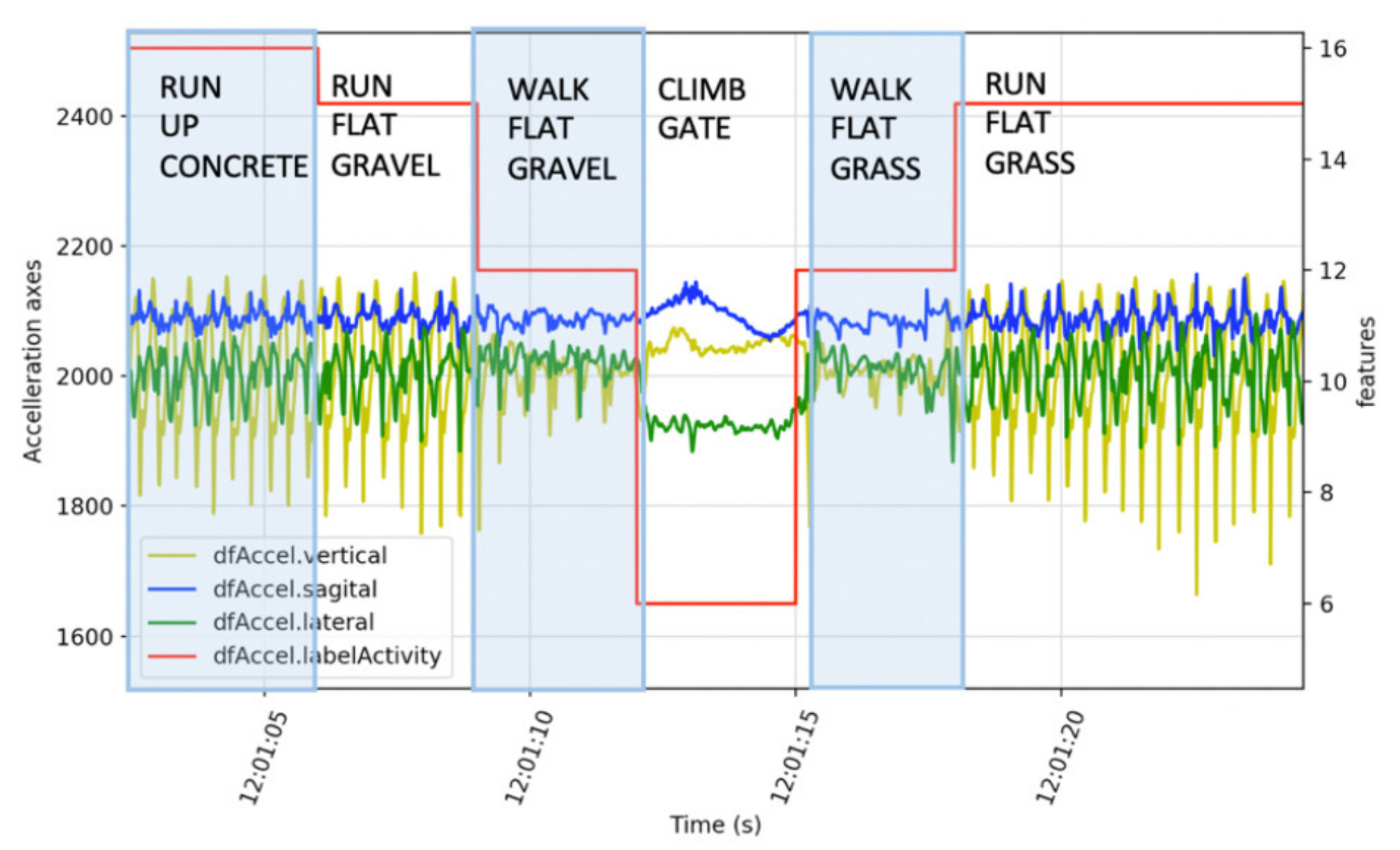
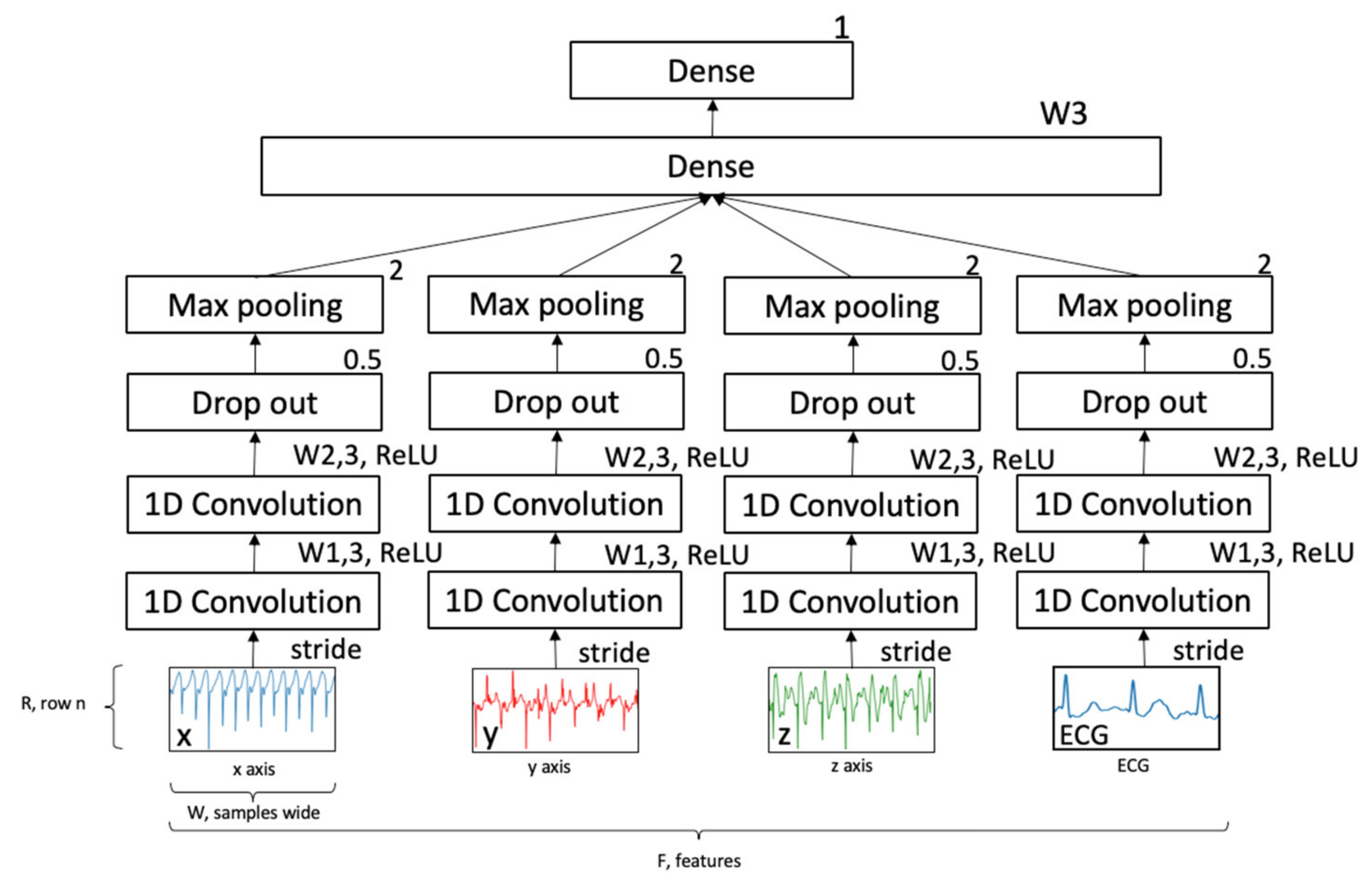
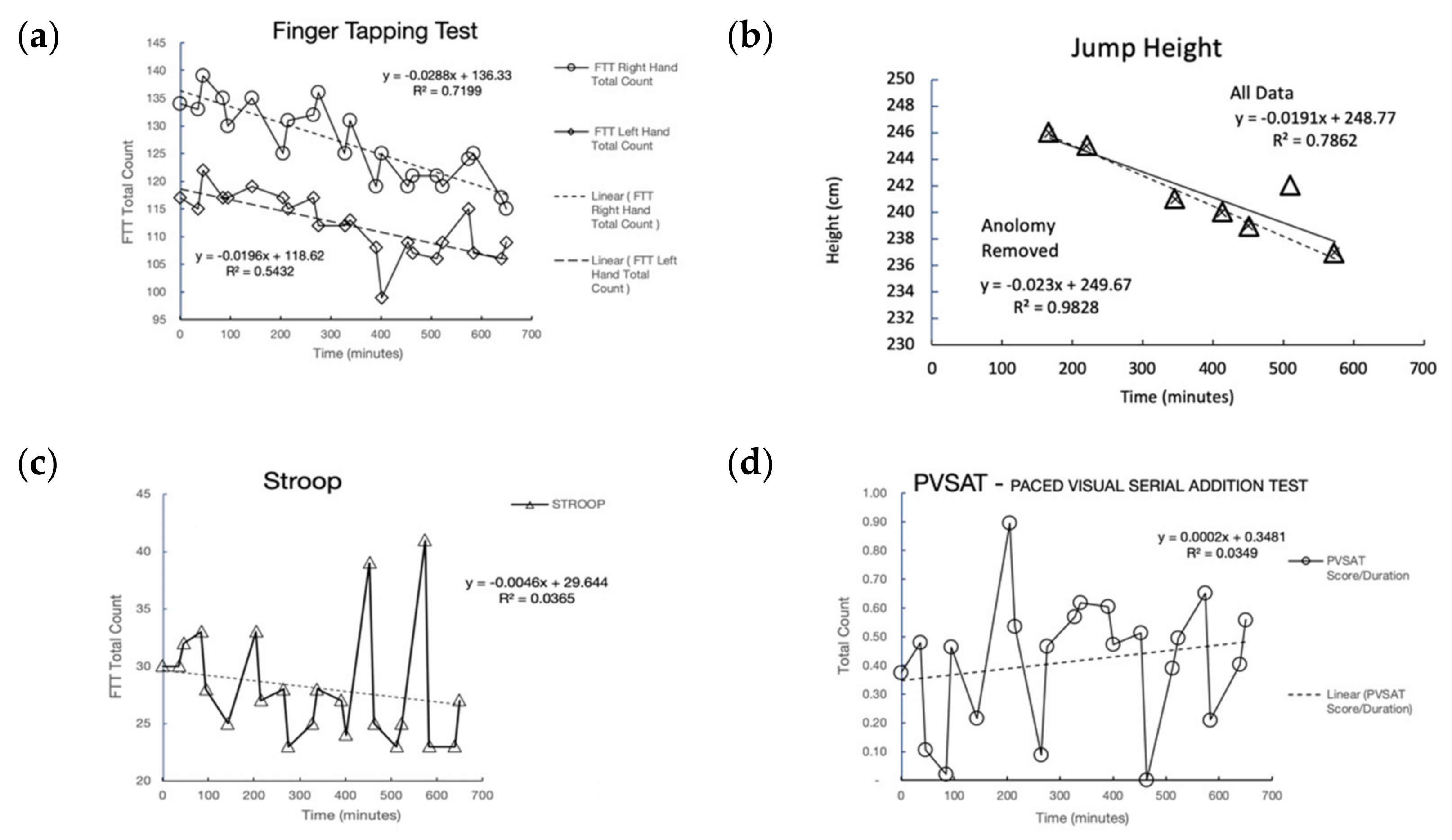
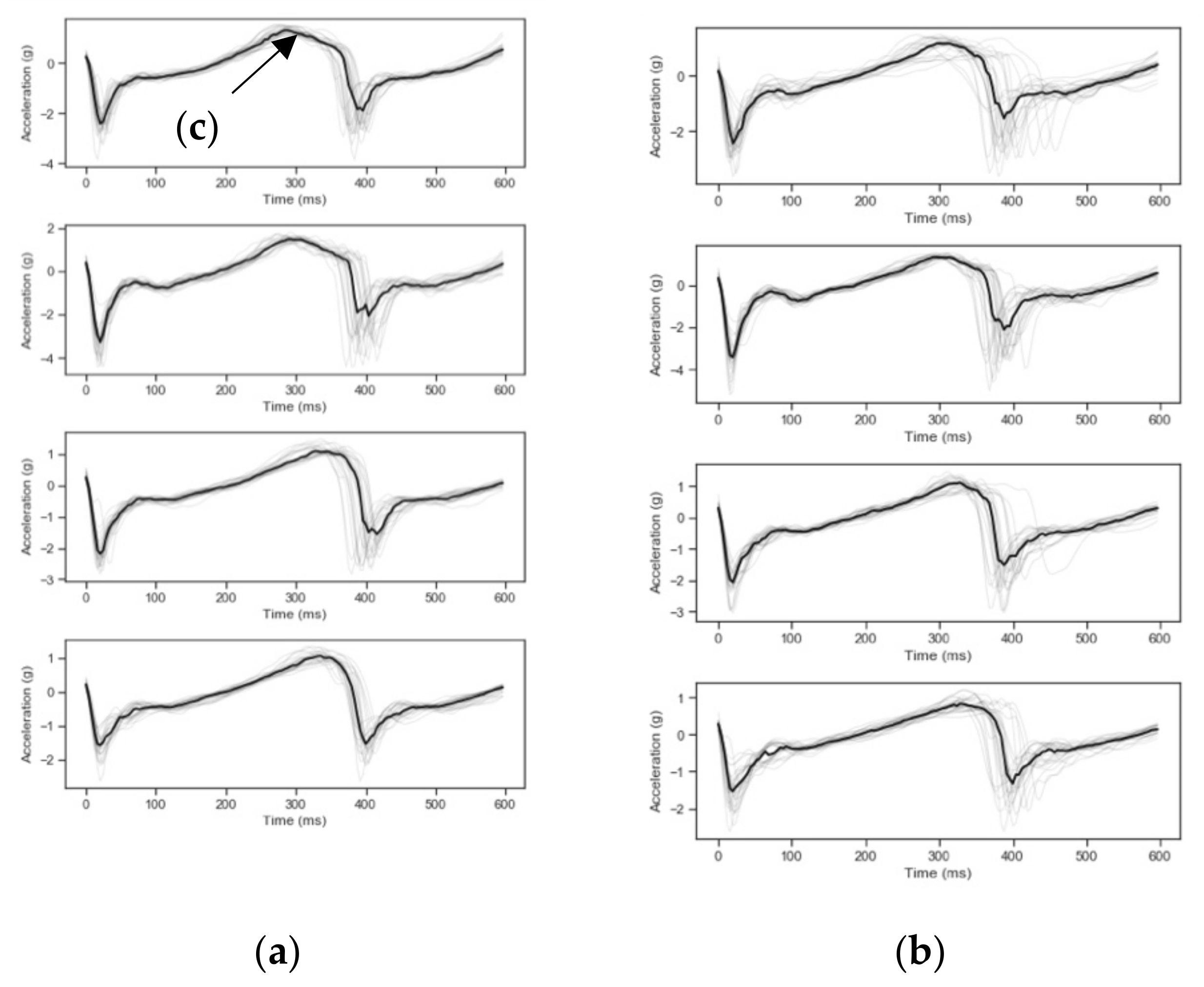
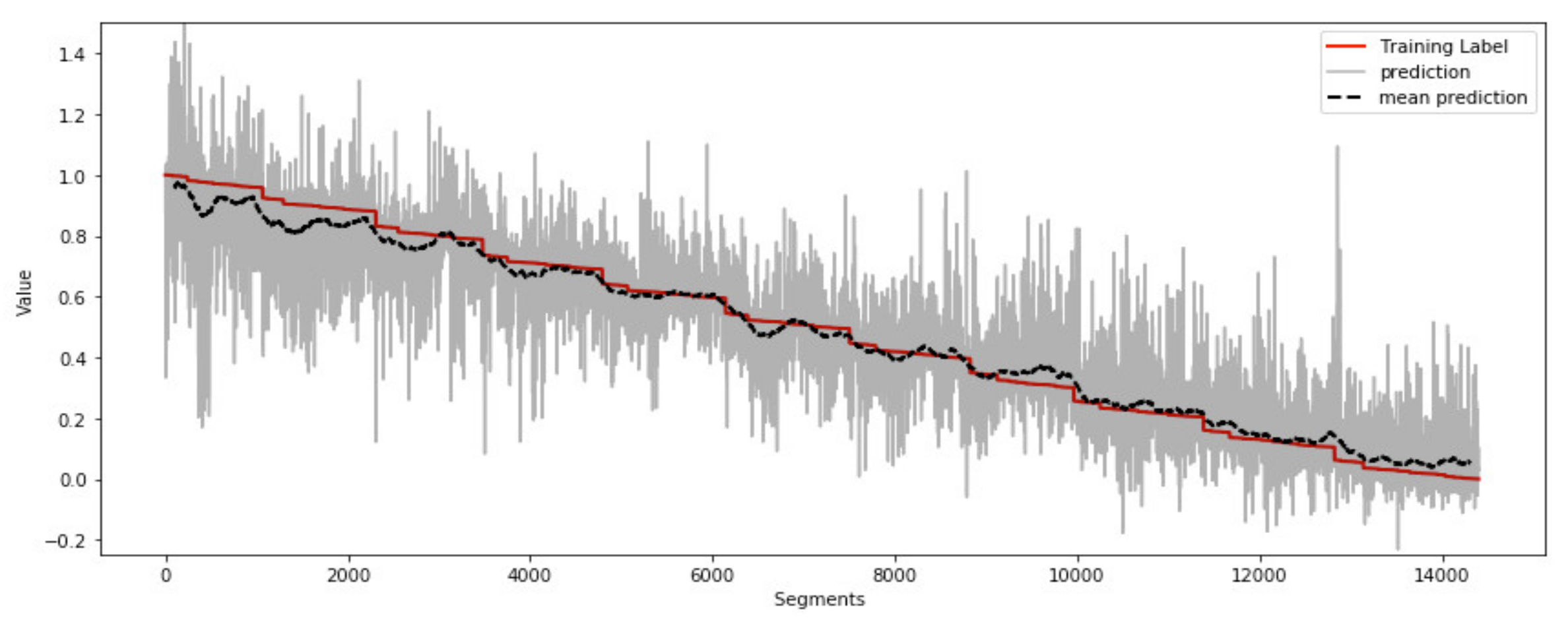

| Assessment | Bio-Psycho-Central Performance | Reference |
|---|---|---|
| Finger Tap Test | Neuro muscular fatigue | [59] |
| Stroop | Cognitive flexibility and selective attention | [61] |
| PVSAT | processing speed, attention, working memory | [62] |
| Trail Making A and B | Motor and executive impairment | [63] |
| Corsi Block test | Spatial memory, Working memory | [64,65] |
| Vertical Jump | Neuromuscular fatigue | [66] |
| Rating of Perceived Exertion | Perceived level of exertion | [16,20,67] |
| Test | All Tests | Post Physical Load | Post Cognitive Load |
|---|---|---|---|
| Jump | 0.78 | - | - |
| Finger Tap Test | |||
| Dominant Hand | 0.72 | 0.76 | 0.67 |
| Non Dominant Hand | 0.54 | 0.51 | 0.60 |
| Stroop (with outliers) | 0.04 | 0.003 | 0.36 |
| Stroop (no outliers) | 0.49 | 0.37 | 0.36 |
| PVSAT | 0.03 | 0.11 | 0.02 |
| Trail Making A | 0.19 | 0.04 | 0.29 |
| Trail Making B | 0.001 | 0.22 | 0.05 |
| Spatial Memory | 0.00 | 0.00 | 0.30 |
| Activity | Data (250 Hz) | Linear Fit MAE200 | Linear Fit RAE200 | Inter-Test Interpolation MAE200 | Inter-Test Interpolation RAE200 |
|---|---|---|---|---|---|
| Run Up | 1,019,002 | 0.145 | 0.225 | 0.134 | 0.240 |
| Run | 732,501 | 0.151 | 0.238 | 0.156 | 0.232 |
| Run Down | 1,843,749 | 0.130 | 0.289 | 0.133 | 0.167 |
| Walk Up | 1,534,500 | 0.136 | 0.303 | 0.125 | 0.411 |
| Walk | 299,997 | 0.238 | 0.683 | 0.235 | 0.726 |
| Walk Down | 20,000 | 0.219 | - | 0.239 | - |
| Open Gate | 56,750 | 0.195 | 0.338 | 0.199 | 0.316 |
| Climb Gate | 65,249 | 0.327 | 0.422 | 0.313 | 0.389 |
Publisher’s Note: MDPI stays neutral with regard to jurisdictional claims in published maps and institutional affiliations. |
© 2021 by the authors. Licensee MDPI, Basel, Switzerland. This article is an open access article distributed under the terms and conditions of the Creative Commons Attribution (CC BY) license (https://creativecommons.org/licenses/by/4.0/).
Share and Cite
Russell, B.; McDaid, A.; Toscano, W.; Hume, P. Predicting Fatigue in Long Duration Mountain Events with a Single Sensor and Deep Learning Model. Sensors 2021, 21, 5442. https://doi.org/10.3390/s21165442
Russell B, McDaid A, Toscano W, Hume P. Predicting Fatigue in Long Duration Mountain Events with a Single Sensor and Deep Learning Model. Sensors. 2021; 21(16):5442. https://doi.org/10.3390/s21165442
Chicago/Turabian StyleRussell, Brian, Andrew McDaid, William Toscano, and Patria Hume. 2021. "Predicting Fatigue in Long Duration Mountain Events with a Single Sensor and Deep Learning Model" Sensors 21, no. 16: 5442. https://doi.org/10.3390/s21165442
APA StyleRussell, B., McDaid, A., Toscano, W., & Hume, P. (2021). Predicting Fatigue in Long Duration Mountain Events with a Single Sensor and Deep Learning Model. Sensors, 21(16), 5442. https://doi.org/10.3390/s21165442








